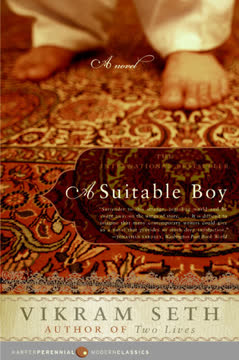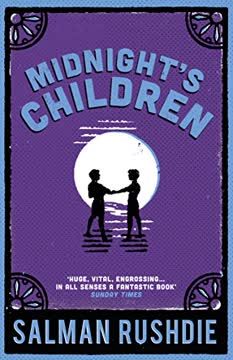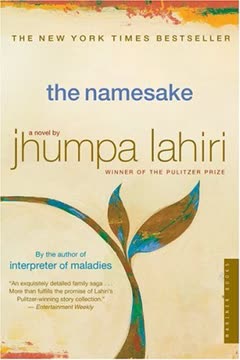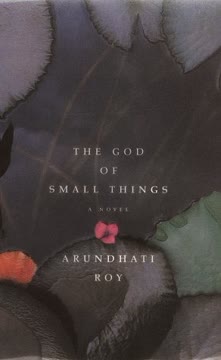Plot Summary
Wedding Under Lamp-Lit Skies
The story opens with the vibrant wedding of Savita Mehra and Pran Kapoor in the garden of Prem Nivas, Brahmpur. The event is a swirl of tradition, expectation, and subtle rebellion. Mrs. Rupa Mehra, the widowed matriarch, is determined to arrange suitable marriages for her children, believing she knows best. Lata, her younger daughter, is quietly resistant, already chafing under the weight of her mother's plans. The wedding is both a celebration and a crucible, where family dynamics, social status, and the pressure of tradition converge. Amidst the rituals, Lata's sense of self and her longing for autonomy begin to surface, foreshadowing the personal and societal struggles that will define her journey.
Mothers, Sons, and Suitors
As the wedding festivities continue, the focus shifts to the ambitions and anxieties of both the Mehras and the Kapoors. Mrs. Rupa Mehra's relentless matchmaking is mirrored by Mahesh Kapoor's insistence that his son Maan settle down. Both parents are haunted by loss and driven by duty, yet their children's desires remain elusive. Maan, charming but aimless, is pressured to marry, while Lata is gently but persistently reminded of her own "duty." The chapter explores the tension between tradition and individuality, as the older generation's certainties clash with the younger's uncertainties, setting the stage for the central conflict: the search for a "suitable boy."
Sisters, Friends, and Fates
Lata finds solace in her friendship with Malati, a spirited medical student who embodies a new kind of Indian womanhood—independent, outspoken, and skeptical of tradition. Their banter and camaraderie offer Lata a glimpse of a life beyond arranged marriages and familial expectations. Meanwhile, the newlywed Savita adapts to her new role, her gentle acceptance contrasting with Lata's quiet rebellion. The sisters' diverging paths highlight the choices facing women in post-independence India: to conform, to resist, or to carve out a space in between.
Arranged Vows, Unspoken Doubts
The wedding rituals unfold with all their prescribed grandeur, but beneath the surface, doubts and discomfort simmer. Lata observes the proceedings with a mix of fascination and skepticism, questioning the logic of arranged unions and the meaning of happiness. The family's history of sacrifice and struggle is ever-present, shaping their choices and fears. The chapter captures the bittersweet nature of tradition: its power to bind and to stifle, to comfort and to confine. Lata's internal monologue signals her growing restlessness and the stirrings of a desire for self-determination.
New Beginnings, Old Wounds
As Savita and Pran embark on their married life, the family is left to reckon with absence and change. Mrs. Rupa Mehra's joy is tinged with sorrow, her thoughts drifting to her late husband and the sacrifices she has made. The family's financial struggles and social anxieties are laid bare, revealing the fragility beneath their public composure. Lata, meanwhile, is both relieved and unsettled by the changes, her own future now the focus of her mother's attention. The chapter explores the interplay of memory and hope, loss and renewal, as the characters navigate the uncertain terrain of post-wedding life.
Letters, Lessons, and Longings
The narrative shifts to the everyday rhythms of Brahmpur: university lectures, music lessons, and the exchange of letters. Lata's academic pursuits and her friendship with Malati offer her a measure of freedom, but the pressure to marry intensifies. Letters—between family members, friends, and potential suitors—become a lifeline, a means of expressing what cannot be said aloud. The written word is both a tool of connection and a source of misunderstanding, as Lata grapples with her feelings and the expectations placed upon her. The chapter is suffused with longing: for love, for understanding, for a life of one's own.
The Suitable Boy Search
Mrs. Rupa Mehra's quest to find Lata a suitable husband becomes the central preoccupation of the family. Prospective matches are evaluated and dismissed, each encounter revealing the complexities of caste, class, and character. Lata is both participant and observer, her ambivalence growing as the search drags on. The process is at once comic and poignant, exposing the absurdities of the marriage market and the genuine fears that drive it. Through it all, Lata's sense of self becomes sharper, her resistance more pronounced, as she begins to imagine alternatives to the path laid out for her.
Forbidden Love, Family Ties
Lata's chance meeting with Kabir Durrani, a charming and intelligent fellow student, ignites a forbidden romance. Their love is immediate and intense, but fraught with obstacles: Kabir is Muslim, and the prospect of an interfaith marriage is unthinkable to both families. The secrecy and urgency of their relationship heighten its intensity, but also its peril. Lata is torn between passion and duty, her heart and her heritage. The chapter explores the limits of love in a society riven by religious and social divisions, and the pain of choices that can never be fully free.
Riots, Rumors, and Reforms
The personal dramas of the Mehras and Kapoors unfold against a backdrop of social unrest. Riots erupt in Brahmpur, fueled by religious animosities and political machinations. The violence exposes the fragility of the new nation and the dangers lurking beneath its surface. Mahesh Kapoor, as Revenue Minister, is drawn into the maelstrom, his ideals tested by the realities of power. The chapter weaves together the public and the private, showing how the fates of individuals are shaped by the forces of history. The search for stability—personal and political—becomes ever more urgent.
Music, Melancholy, and Meaning
Music is a recurring motif, offering both escape and insight. Maan Kapoor, restless and discontented, is drawn to the courtesan Saeeda Bai, whose singing is as intoxicating as her presence. Their relationship is fraught with desire, guilt, and the impossibility of fulfillment. Music lessons, poetry readings, and artistic pursuits provide moments of transcendence, but also underscore the characters' loneliness and longing. The chapter explores the power of art to heal and to wound, to connect and to isolate, as each character seeks meaning in a world that often seems indifferent to their pain.
Choices, Consequences, and Change
As the search for a suitable boy reaches its climax, Lata is faced with a momentous choice: to follow her heart, to obey her family, or to forge her own path. The consequences of her decision ripple outward, affecting not only her own life but those of everyone around her. Other characters, too, are forced to confront the costs of their actions: Maan's affair with Saeeda Bai leads to scandal and exile; Mahesh Kapoor's political ambitions are threatened by personal and public crises. The chapter is a meditation on the nature of choice, the inevitability of consequence, and the possibility of change.
Endings, Endurance, and Hope
In the end, Lata makes her choice—not for passion or for duty, but for a kind of pragmatic hope. She marries Haresh, a hardworking and decent man, choosing stability and possibility over the uncertainties of forbidden love or familial pressure. The other characters, too, find ways to endure: some through compromise, others through defiance, all through a measure of grace. The novel closes with a sense of continuity and renewal, as the cycles of love, loss, and longing begin anew. The search for a suitable boy—and a suitable life—remains unfinished, but the hope for happiness endures.
Characters
Lata Mehra
Lata is the heart of the novel—a young woman caught between tradition and modernity, family and self. Her journey is one of self-discovery, as she navigates the pressures of arranged marriage, the allure of forbidden love, and the desire for autonomy. Lata's relationships—with her mother, her siblings, her friends, and her suitors—reveal her complexity: she is dutiful yet questioning, passionate yet pragmatic. Her psychological arc is marked by a growing confidence and clarity, as she learns to balance her own needs with those of those she loves. Lata's ultimate choice is both a personal and a generational one, reflecting the dilemmas facing women in a changing India.
Mrs. Rupa Mehra
Mrs. Mehra is a widow whose life revolves around her children's happiness—defined, for her, as successful marriages. Her grief for her late husband and her anxiety about the future drive her relentless matchmaking. She is both comic and tragic: her emotional outbursts, her superstitions, and her manipulations are rooted in genuine love and fear. Psychologically, she is both strong and fragile, her willfulness masking a deep vulnerability. Her relationship with Lata is central: a dance of affection, frustration, and mutual dependence. Mrs. Mehra embodies the generational tensions at the heart of the novel.
Maan Kapoor
Maan is the younger son of Mahesh Kapoor, a man of charm and appetites, unable to find purpose or peace. His affair with Saeeda Bai is both a rebellion against his father and a search for meaning. Maan's psychological complexity lies in his oscillation between pleasure and guilt, love and self-loathing. He is both a victim and an agent of chaos, his actions setting off a chain of events that affect everyone around him. Maan's journey is one of exile and return, of learning the limits of desire and the necessity of responsibility.
Mahesh Kapoor
As Revenue Minister of Purva Pradesh, Mahesh Kapoor is a man of principle and pragmatism, torn between public duty and private turmoil. His commitment to land reform and social justice is tested by the realities of power and the failings of his family. Psychologically, he is driven by a need for control and a fear of failure, both as a father and as a leader. His relationship with Maan is fraught with disappointment and hope, while his friendship with the Nawab Sahib reveals the complexities of post-independence politics. Mahesh Kapoor is a symbol of the new India: visionary, flawed, and perpetually embattled.
Kabir Durrani
Kabir is a fellow student at Brahmpur University, whose romance with Lata is as intense as it is impossible. As a Muslim in a Hindu-majority society, Kabir represents both the promise and the peril of modern India. He is intelligent, sensitive, and sincere, but also pragmatic and aware of the limits imposed by society. His relationship with Lata is marked by longing and restraint, hope and resignation. Kabir's psychological depth lies in his ability to love without illusion, to desire without expectation. He is both a catalyst and a casualty of the novel's central conflicts.
Haresh Khanna
Haresh is the "suitable boy" Lata ultimately chooses—a self-made man, industrious and sincere, if somewhat unromantic. He represents the virtues of hard work, adaptability, and compromise. Haresh's psychological makeup is defined by resilience and a desire for stability, both for himself and for those he loves. His courtship of Lata is marked by awkwardness and earnestness, a counterpoint to the passion of her relationship with Kabir. Haresh's presence in the novel is a reminder that happiness is often found not in grand gestures, but in the quiet accumulation of small, steady acts of care.
Savita Kapoor
Savita, Lata's elder sister, is the model of the "good daughter"—obedient, kind, and accepting of her fate. Her marriage to Pran is arranged, but she finds contentment and even love in her new life. Savita's psychological strength lies in her ability to adapt, to find joy in the everyday, and to support those around her. She is a stabilizing force in the family, her calmness a foil to Lata's restlessness. Savita's journey is less dramatic than Lata's, but no less significant: she embodies the quiet heroism of endurance.
Pran Kapoor
Pran is a lecturer in English at Brahmpur University, a man of learning and integrity, but also of vulnerability. His struggles with asthma, departmental politics, and the demands of marriage reveal his sensitivity and his limitations. Pran's psychological arc is one of gradual self-assertion, as he learns to navigate the treacherous waters of academia and family life. His relationship with Savita is marked by mutual respect and growing affection, a testament to the possibility of happiness within the bounds of tradition.
Malati Trivedi
Malati is Lata's confidante and role model, a medical student who defies convention and pursues her own path. She is witty, fearless, and compassionate, her presence a source of strength for Lata. Malati's psychological resilience is rooted in her experience of loss and her determination to succeed. She is both a critic and a champion of her friend, pushing Lata to question, to dream, and to act. Malati represents the possibilities of a new India, where women can aspire to more than marriage.
Saeeda Bai
Saeeda Bai is a singer of rare talent and beauty, whose allure captivates Maan and many others. She is both a symbol and a victim of a vanishing world, her art and her life shaped by the contradictions of desire and respectability. Saeeda's psychological complexity lies in her ability to love and to manipulate, to inspire and to destroy. Her relationship with Maan is a dance of passion and pain, a reminder of the costs of longing and the limits of redemption.
Plot Devices
Interwoven Family Sagas
The novel's structure is built on the interweaving of four extended families—the Mehras, Kapoors, Chatterjis, and Nawabs—each representing a different facet of Indian society. Their stories intersect through marriage, friendship, politics, and rivalry, creating a rich tapestry of relationships. This device allows the narrative to explore the complexities of caste, religion, class, and gender, while maintaining a sense of intimacy and immediacy. The interlocking plots mirror the interconnectedness of personal and political life in post-independence India.
Marriage as Social and Narrative Engine
The quest for a "suitable boy" is both the central plot and a metaphor for the search for stability in a rapidly changing world. Marriage negotiations, proposals, and rejections drive the action, revealing the anxieties and aspirations of individuals and families. The device of the marriage market exposes the absurdities and cruelties of tradition, while also offering moments of genuine connection and hope. The tension between arranged and love marriages is a recurring motif, reflecting the broader conflict between tradition and modernity.
Letters and Communication
Letters—between family members, friends, and lovers—are a key narrative device, providing insight into characters' inner lives and advancing the plot. The act of writing and reading letters becomes a way of negotiating distance, desire, and duty. Misunderstandings and missed connections are frequent, underscoring the difficulties of communication in a world governed by secrecy and constraint. The device highlights the power of words to both connect and divide.
Political and Social Backdrop
The novel is set against the backdrop of post-independence India, with its political upheavals, communal riots, and social reforms. The personal stories of the characters are inextricably linked to the larger currents of history, from land reform to religious violence. The device of embedding individual dramas within national crises allows the narrative to explore the ways in which history shapes—and is shaped by—ordinary lives. Foreshadowing and parallelism are used to connect the fates of characters to the fate of the nation.
Music and Poetry as Motif
Music and poetry recur throughout the novel, serving as both escape and confrontation. Characters find meaning, comfort, and identity in art, but also encounter its limitations and dangers. The motif of music—especially in the relationship between Maan and Saeeda Bai—serves as a metaphor for longing, loss, and the search for transcendence. Poetry readings, music lessons, and artistic pursuits are woven into the fabric of daily life, enriching the narrative and deepening its emotional resonance.
Analysis
Through the intertwined lives of its characters, the novel explores the tensions between duty and desire, family and self, past and future. The central question—how to find a "suitable" life, not just a suitable boy—resonates across generations and social divides. The novel's genius lies in its ability to render the particularities of Indian society with warmth, humor, and insight, while also addressing universal themes of love, loss, and longing. The lessons are both personal and political: that happiness is often found in compromise, that freedom comes with a cost, and that the search for meaning is both endless and essential. In the end, the novel offers no easy answers, but affirms the enduring power of hope, resilience, and the human capacity for change.
Last updated:
Review Summary
A Suitable Boy is a sweeping epic set in 1950s India, following four interconnected families as they navigate love, politics, and social change. Readers praise Seth's vivid characters, intricate plotlines, and immersive portrayal of Indian culture. The novel's length (1500+ pages) is both daunting and rewarding, with many finding it difficult to put down. While some criticize its verbosity, most applaud Seth's masterful storytelling and historical detail. The central story of Lata's search for a husband captivates readers, though opinions on the ending are divided.
A Bridge of Leaves Series
Download PDF
Download EPUB
.epub digital book format is ideal for reading ebooks on phones, tablets, and e-readers.









